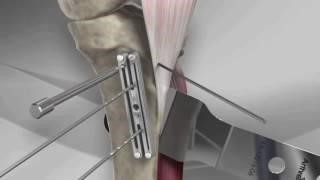Knee dislocation is different than patella dislocation. Knee dislocation is a medical emergency due to the risk of injury to the nerves and blood vessels behind the knee that supply the lower leg. The femur (thigh bone) completely dissociates from the tibia (shin bone). The ligaments that stabilize the inside and the sides of the knee are usually torn.
What are the causes?
Knee dislocation occurs during high-energy trauma (motor vehicle accident, collisions during sports and fall from a height).
What are the symptoms?
Knee dislocation causes immediate pain and loss of function of the leg. Traumatic shock may occur. Swelling, numbness, tingling and cold sensation may occur depending on the extent of the injury.
How is it diagnosed?
Dr. Chandrasekaran will perform a thorough physical exam at the time of injury. A deformed leg is visualized and should be immediately stabilized and the patient brought to the nearest hospital for full evaluation. X-rays will confirm the diagnosis. Nerve and blood flow studies will be performed to evaluate potentially limb threatening injuries. MRI is performed to evaluate the cartilage and ligaments surrounding the knee.
How it is treated?

Non-Operative
Unless other injuries are sustained at the time of knee dislocation that prohibit the patient from surgery, non-operative treatment is not a consideration.

Operative
Immediate surgery is indicated for initial stabilization of the knee and to repair any nerves or blood vessels that are damaged during the injury. Eventually, ligament reconstruction is performed at the surgeon’s discretion to restore function to the leg. Surgeries may include ACL, PCL, ALL, MCL, posterolateral corner (PLC) repair and/or reconstruction.

The patella (aka-kneecap) is a floating bone above the knee joint that is held in place by tendons, a ligament (medial patellofemoral ligament/MPFL) and soft tissue surrounding the joint (aka- capsule) when the knee is straight.
What are the causes?
Patella instability is usually caused by a combination of factors, including trauma, forceful quadriceps muscle contraction and/or anatomical and genetic factors that increase the risk of dislocation (females>males due to greater Q-angle, shallow groove, collagen tissue disorders resulting in hyperflexibility).
What are the symptoms?
Patella instability may cause the patient to feel like the knee is giving out. Patella dislocation causes immediate pain and obvious deformity with the patella located on the outside of the groove (typically towards the outside of the leg). Motion and function are not possible with patella dislocation.
How is it diagnosed?
Dr. Chandrasekaran will perform a thorough history and physical exam, aided by X-rays. In cases of patella instability, Dr. Chandrasekaran may be able to move the patella out of the groove in a controlled manner. The patella may move in a J pattern when extending the knee, but full range of motion and strength are preserved.
In cases of patella dislocation, range of motion will be minimal and the knee will have a visible deformity. X-rays will show the dislocated patella. After reduction, MRI may be helpful to evaluate the ligament that holds the patella in the groove (MPFL) and the cartilage around the knee to ensure it wasn’t damaged during the dislocation.
How it is treated?

Non-Operative
For patella instability/subluxation, physical therapy will be prescribed to strengthen the inner quadriceps muscle. A brace will provide additional support and keep the kneecap in its groove.
Initial treatment of patella dislocation should be non-operative. Dr. Chandrasekaran may prescribe anti-inflammatory medication, cryotherapy and rest. The leg may be placed in a brace designed to hold the kneecap firmly in the groove and allow the injured ligaments to heal. An initial period of immobilization is followed by physical therapy, initiated at Dr. Chandrasekaran’s discretion. The patient may return to sports when strength and range of motion are equal to the opposite knee.

Operative
Surgical treatment is indicated in cases of dislocation if the patient fails non-operative treatment (continued pain, instability) or other structures (MPFL, joint cartilage) were injured at the time of dislocation. If fragments of joint cartilage (aka- loose bodies) are identified, minimally-invasive arthroscopic surgery can be performed to repair or remove the fragments (see OCD in Arthritis section). If a patient suffers two or more dislocations, then the surgeon may recommend a procedure to stabilize the kneecap (MPFL reconstruction/repair). Other anatomic causes of instability can also be addressed through an open incision at the time of surgery (shallow groove=Trochleoplasty, poor alignment=Tibial Tubercle Osteotomy).
